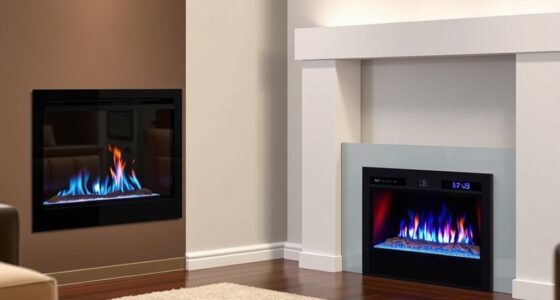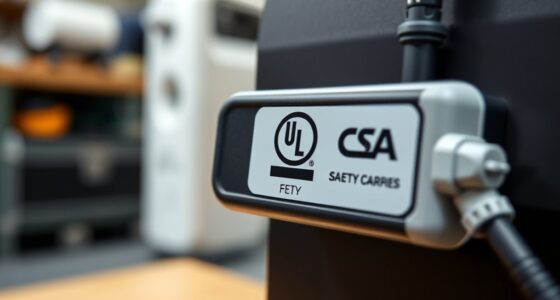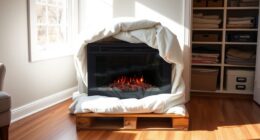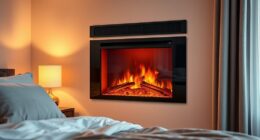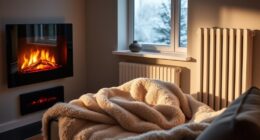To guarantee safe and reliable operation, you need a dedicated 120V outlet rated for the electric fireplace’s wattage, typically around 12.5 amps, with proper grounding. Avoid using extension cords or power strips to prevent overloads and potential fire hazards. Larger units may require a 240V connection and professional installation. Making certain your electrical system matches these requirements helps prevent circuit overloads and ensures ideal performance. Keep going to learn more about proper setup and safety tips.
Key Takeaways
- Ensure the outlet can handle the fireplace’s wattage, typically requiring a dedicated 120V circuit with sufficient amperage.
- Never use extension cords or power strips; always plug directly into a properly rated outlet.
- Verify wiring and circuit capacity meet local electrical codes, especially for larger or high-voltage models.
- Use a dedicated circuit to prevent interference and voltage fluctuations from other appliances.
- Consult a qualified electrician for proper installation, grounding, and any necessary circuit upgrades for safety.
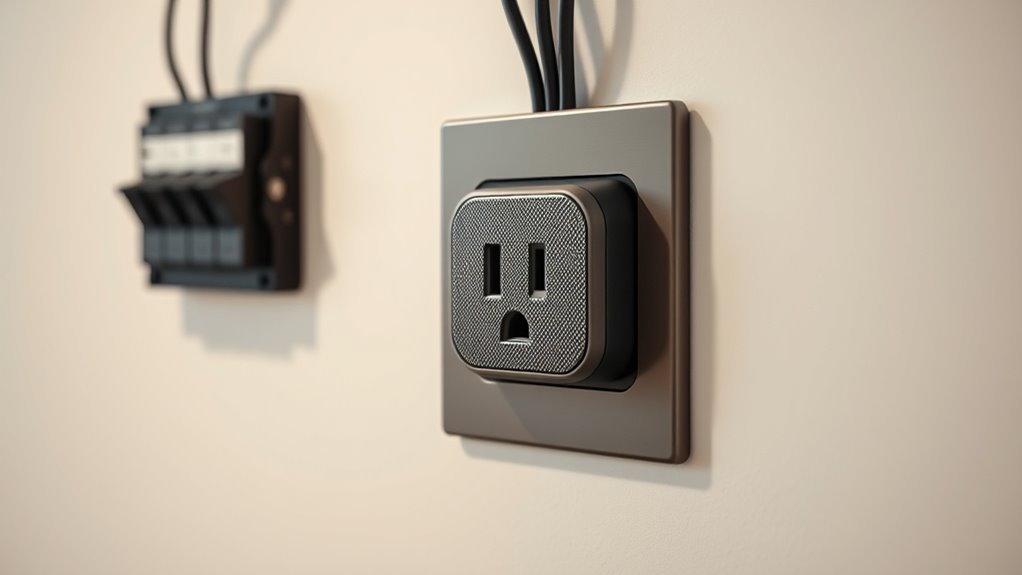
Installing an electric fireplace requires understanding the specific outlet and circuit requirements to guarantee safe and proper operation. This is essential because electric fireplaces can draw significant power, and improper wiring or outlets can lead to electrical safety hazards. Before installing, you need to assess the power consumption of your unit carefully. Most electric fireplaces specify their wattage, which directly impacts the type of outlet and circuit you’ll need. For example, a model that uses 1500 watts consumes about 12.5 amps at 120 volts, meaning your circuit must be capable of handling that load without overloading. Ignoring power consumption details can cause circuit breakers to trip frequently or, worse, increase the risk of electrical fires.
Electrical safety is a top priority when setting up your electric fireplace. You should never plug the unit into an extension cord or power strip, as these can overheat and pose fire risks, especially if the fireplace draws high power. Instead, ensure that the outlet you’re using is dedicated solely to the fireplace. This helps prevent overloads that could compromise safety or damage your wiring. If your existing outlet isn’t rated for the fireplace’s power needs, consider having a qualified electrician install a new, dedicated circuit. This not only ensures safety but also maintains the longevity of your electrical system by preventing overloads and voltage drops.
Never plug your electric fireplace into an extension cord or power strip to ensure safety and prevent electrical hazards.
When planning your installation, check whether your home’s wiring can support the required circuit. Many electric fireplaces need a standard 120-volt outlet, but some larger units may require a 240-volt connection, similar to what is used for dryers or ovens. For these, you’ll need a specialized circuit and outlet installed by a professional. Proper grounding and circuit protection devices, such as circuit breakers rated for the specific amperage, are critical for electrical safety. An electrician can verify that your wiring meets local electrical codes and recommend the appropriate upgrades if needed. Proper wiring practices are fundamental to ensuring a safe and reliable electrical setup.
Finally, it’s crucial to use a dedicated circuit for your electric fireplace to avoid interference with other appliances. Multiple devices sharing a circuit can cause voltage fluctuations, which not only affect your fireplace’s performance but also pose electrical safety hazards. By carefully selecting the right outlet and ensuring your circuit can handle the power consumption, you create a safe environment that maximizes your fireplace’s efficiency and lifespan. Taking these precautions helps protect your home and loved ones while enjoying the warmth and ambiance your electric fireplace provides.
Frequently Asked Questions
Can I Install an Electric Fireplace Outlet Outdoors?
Yes, you can install an electric fireplace outlet outdoors if you follow outdoor outlet requirements. Make sure to select weatherproof outlet options designed for exterior use, which resist moisture and weather conditions. You’ll also need to install a GFCI outlet for safety and ensure proper weatherproof covers are in place. This setup keeps your outdoor electric fireplace safe, functional, and compliant with electrical codes.
What Is the Typical Amperage Needed for a Standard Electric Fireplace?
A standard electric fireplace typically requires about 12 to 15 amps, which translates to a modest power consumption but calls for a circuit with enough capacity to handle the load comfortably. You should guarantee your circuit can support this, avoiding any strain that might cause flickering or interruptions. Think of it as giving your cozy warmth the perfect power flow, ensuring safety and consistent comfort every time you enjoy your fireplace.
Are GFCI Outlets Required for Electric Fireplace Circuits?
You don’t necessarily need GFCI outlets for electric fireplace circuits, but GFCI requirements depend on local electrical codes and specific installation locations. GFCI outlets provide essential circuit protection by preventing electrical shocks, especially in areas prone to moisture. Check your local codes and consult a licensed electrician to determine if GFCI protection is necessary for your electric fireplace circuit to ensure safety and compliance.
Can I Connect Multiple Electric Fireplaces to a Single Circuit?
You can connect multiple electric fireplaces to a single circuit if the circuit capacity is sufficient for the total power draw. To guarantee safe power distribution, calculate the combined wattage of all fireplaces and compare it to your circuit’s amperage. Avoid overloading the circuit, as it can cause tripped breakers or electrical hazards. When in doubt, consult an electrician to assess your power setup and prevent potential issues.
What Safety Precautions Should I Follow During Installation?
You must prioritize safety during installation; neglecting grounding practices can lead to dangerous shocks. Always turn off the circuit breaker before starting, ensuring no power flows through the outlet. Use properly rated circuit breakers to prevent overloads, and double-check all connections. Keep moisture away, and confirm the outlet’s grounding is secure. These precautions aren’t just recommendations—they’re your safeguard against electrical hazards, keeping your home safe and your installation trouble-free.
Conclusion
To keep your electric fireplace operating safely and efficiently, make sure your outlet and circuit meet the proper requirements. Ignoring these details isn’t just risky—it’s like inviting a potential firestorm into your home! By following the right standards, you’ll enjoy cozy warmth without worry. Remember, a properly wired outlet is the backbone of your comfort, turning your space into a haven of warmth and safety that lasts for years to come.


